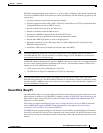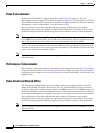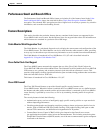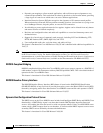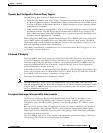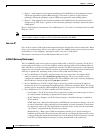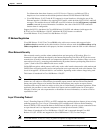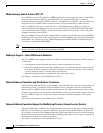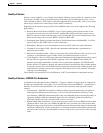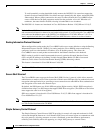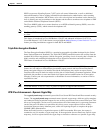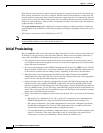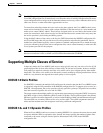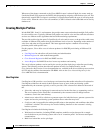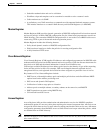
1-11
Cisco uBR924 Software Configuration Guide
OL-0337-05 (8/2002)
Chapter 1 Overview
Cisco IOS Software Release Feature Sets
Quality of Service
Quality of service (QoS) is a set of features that identify different types of traffic on a network so that
certain types of traffic can be given higher priority than other types of traffic that have only a “best
effort” attempt at delivery. This feature is especially important for real-time traffic, such as voice traffic,
where delays would have a serious impact on the traffic’s usefulness.
Depending on the software image used, the Cisco uBR924 cable access router supports the following
QoS features:
• Resource Reservation Protocol (RSVP)—Layer 3 QoS signaling protocol that provides for the
reservation of resources across an IP network. Applications running on IP end systems can use
RSVP to indicate to other nodes the nature (such as bandwidth, jitter, and maximum burst) of the
packet streams they want to receive. RSVP is defined in RFC 2205.
• Distributed Open Signaling Architecture/Session Initialization Protocol (DOSA/SIP)—Call flow
protocol that uses the AT&T VoIP over cable architecture.
• DOSA/QoS—Quality of service mechanism used on the AT&T VoIP over cable architecture.
• Committed Access Rate (CAR)—Specifies the minimum bandwidth that is guaranteed for a
particular type of traffic.
• Multi-Service Identifier (SID)—Allows a service provider to offer different classes of service to its
customers, so that different types of traffic can be given different priorities of service.
• Traffic Shaping—Process of delaying packets that would otherwise be dropped because they exceed
the rate limit on a particular cable modem’s upstream. The Cisco uBR924 router buffers the
upstream packet until bandwidth is available. This is particularly important with TCP/IP traffic
because when a TCP packet is dropped, the destination device automatically drops all other packets
it currently contains in its receive buffer and then requests the retransmission of those packets. This
retransmission of packets increases the congestion that already exists in this situation, drastically
reducing overall throughput.
These features are introduced in Cisco IOS Release 12.0(7)T and enhanced in subsequent releases.
Quality of Service—DOCSIS 1.0+ Extensions
In addition to the other QoS features, DOCSIS 1.1 supports a number of features that are required for
the delivery of high quality voice traffic. To use these features before the DOCSIS 1.1 specification is
finalized, Cisco has created the DOCSIS 1.0+ extensions that contain the most important of these
features.
• Concatenation—DOCSIS concatenation combines multiple upstream packets into one packet to
reduce packet overhead and overall latency, as well as increase transmission efficiency. Using
concatenation, a DOCSIS cable modem makes only one bandwidth request for multiple packets, as
opposed to making a different bandwidth request for each individual packet; this technique is
especially effective for bursty real-time traffic, such as voice calls.
• Dynamic Multi-SID Assignment—To give priority to voice traffic, the Cisco uBR924 router assigns
a different SID to each voice port. Without the DOCSIS 1.0+ extensions, the router creates these
SIDs during the provisioning process, and the SIDs remain in effect until the router is rebooted with
a different configuration. As part of this process, a minimum guaranteed bandwidth is permanently
allocated to the voice ports; this bandwidth is reserved to the voice ports even if no calls are being
made.



